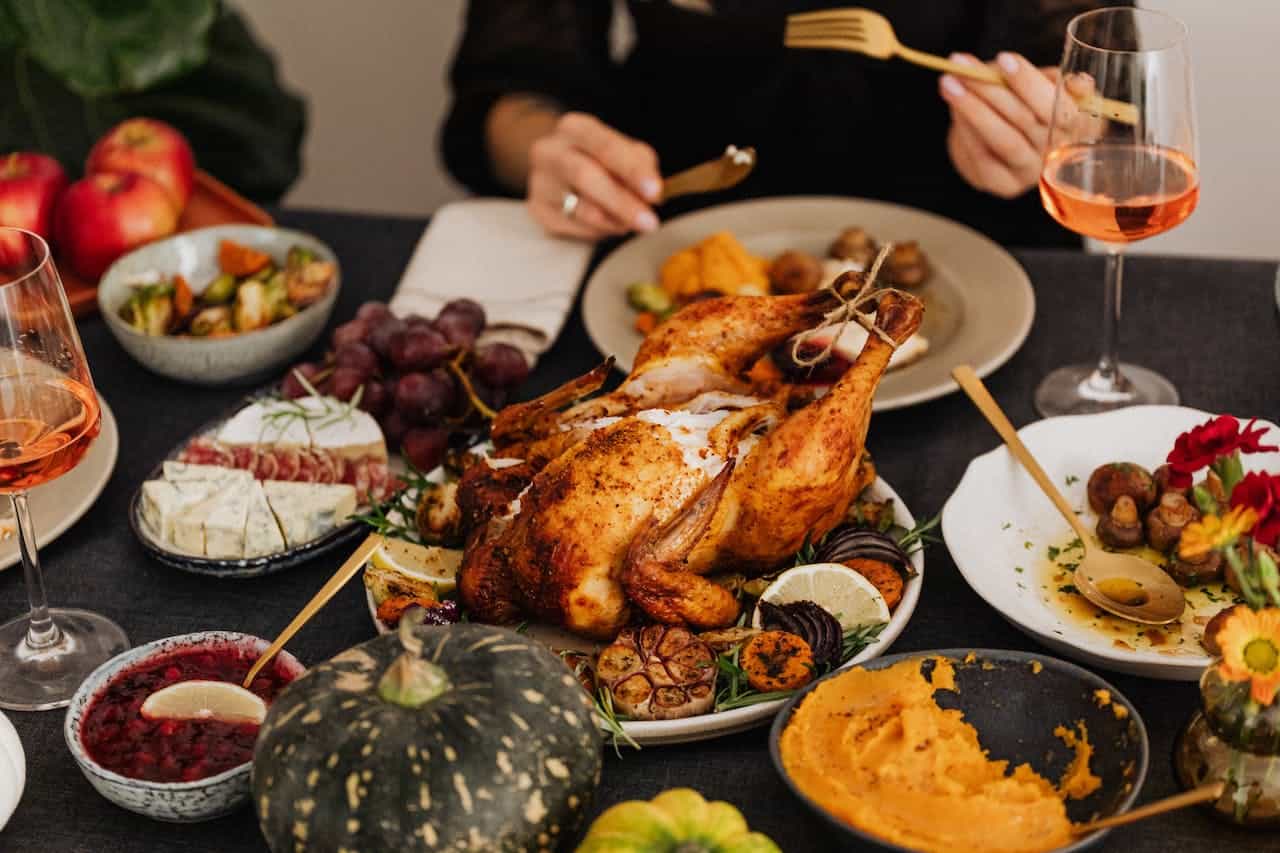
14 Nov The Best Way to Cook a Turkey: According to Science
Thanksgiving is the time of year when families gather around the dinner table to enjoy a delicious feast, with the turkey taking center stage. However, cooking a turkey can be intimidating, especially if you want to achieve that perfect balance of moist, flavorful meat and a crispy, golden-brown skin. In this comprehensive guide, we will delve into the science behind cooking the perfect turkey. From choosing the right bird to mastering different cooking techniques, we will arm you with the knowledge to impress your guests and create a memorable Thanksgiving meal.
Choosing the Right Bird
The first step in cooking a perfect turkey is selecting the right bird. Consider opting for a higher-quality, free-range turkey, as these tend to have a more intense flavor and a higher amount of dark meat. Dark meat is rich in myoglobin molecules, which contribute to both the taste and color of the meat. Free-range turkeys, which have more muscle activity, develop more myoglobin, resulting in a gamier flavor and a greater depth of color.
When it comes to size, plan for approximately 1 pound of turkey per person. This allows for enough meat for each guest and leaves room for leftovers. If you are hosting a larger gathering, consider cooking two smaller turkeys or a whole turkey and a turkey breast. Smaller birds are easier to handle and cook more evenly.

Thawing the Turkey
If you have purchased a frozen turkey, proper thawing is essential to ensure even cooking. The safest method is to thaw the turkey in the refrigerator. Allow approximately 24 hours of thawing time for every 4 to 5 pounds of turkey. Place the wrapped turkey on a tray on the bottom shelf of the refrigerator to prevent any juices from leaking onto other foods.
If you’re short on time, you can thaw the turkey using the cold water method. Keep the turkey in its original packaging and submerge it in a sink or container filled with cold water. Change the water every 30 minutes, and allow 30 minutes of thawing time per pound of turkey.
*Note: NEVER THAW FROZEN FOOD IN WARM WATER.
USDA
For those who forget to thaw the turkey altogether, it is possible to roast a frozen turkey. However, be prepared for a longer cooking time, as a frozen turkey typically requires 50% more cooking time than a thawed turkey.
Preparing the Turkey
Before cooking the turkey, it’s important to properly prepare it. Start by carefully removing the giblets from the turkey’s cavity. These can be discarded or used to make gravy. Avoid rinsing the turkey with water, as this can spread bacteria. Instead, pat the turkey dry with paper towels both inside and out.
When it comes to stuffing, it is safer to cook it separately from the turkey. Stuffing cooked inside the turkey can absorb juices that may contain bacteria, and it can be challenging to ensure that the stuffing reaches a safe internal temperature of 165°F. To ensure food safety, prepare the stuffing separately and cook it to the appropriate temperature.
Brining Methods
Brining a turkey can result in tender, juicy, and flavorful meat. There are three common methods of brining: unbrined, dry brined, and salt water brined turkey.
Wet Brining
Wet brining involves submerging the turkey in a saltwater solution for an extended period, usually 12-24 hours. The saltwater solution typically includes salt, sugar, and various aromatics such as herbs, spices, and citrus zest. The saltwater solution helps the turkey absorb moisture, resulting in a juicier and more flavorful end product. However, wet brining requires a large container to hold the turkey and the brine, and it also necessitates refrigeration space. Additionally, some people find that the texture of the meat can become slightly waterlogged with wet brining.
Dry Brining
Dry brining is a method of seasoning and tenderizing meat by rubbing it with salt and allowing it to rest. Unlike wet brining, which involves soaking the meat in a saltwater solution, dry brining requires only salt and the meat itself. The salt draws out moisture from the meat, which then dissolves the salt and creates a brine that is reabsorbed into the meat. This process results in more flavorful and juicier meat. Dry brining also allows the skin to become crispy during roasting. Additionally, dry brining can be enhanced by adding other seasonings such as herbs, spices, or citrus zest to the salt, further infusing the meat with flavor.
Unbrined
Brining is optional and can be skipped if you prefer a simpler roasting method. It’s important to note that pre-brined turkeys should not be brined again to avoid excessive saltiness.
Cooking Methods
Now that the turkey is prepared, it’s time to choose a cooking method. There are several options to consider, and each has its own advantages and unique flavors.
Traditional Roasting
Traditional roasting is the most common cooking method for turkey, and it is relatively easy to master. Preheat the oven to 325°F, place the turkey on a rack in a roasting pan, and cook until the internal temperature reaches 165°F in the thickest part of the thigh, wing, and breast. Let the turkey rest for 15-20 minutes before carving.
Spatchcocking
Spatchcocking, also known as butterflying, involves removing the turkey’s backbone and flattening it before cooking. This method reduces cooking time and ensures even heat distribution. To spatchcock a turkey, use kitchen shears to cut along both sides of the backbone and remove it. Then, flip the bird over and press down firmly to flatten it. Brush the turkey with olive oil, season with salt and pepper, and roast at 450°F for approximately 70 minutes for a 12-pound turkey.
Deep Frying
Deep frying a turkey results in a crispy skin and juicy meat. However, it requires caution and careful preparation due to the large amount of hot oil involved. Deep frying should only be done outdoors and with a completely thawed turkey. Follow the manufacturer’s instructions for your deep fryer, and never leave the turkey unattended. The turkey is safe to eat when it reaches an internal temperature of 165°F.
Grilling or Smoking
Grilling or smoking a turkey can add smoky flavors and create a unique taste experience. Grilling involves cooking the turkey over direct heat, while smoking is a slow and indirect cooking method. Both methods require a grill or smoker and careful attention to temperature control. Cooking times can vary depending on the size and type of the turkey, as well as the cooking temperature. Use a meat thermometer to ensure the turkey reaches an internal temperature of 165°F.
Cooking Tips for Flavorful Results
Regardless of the cooking method you choose, there are a few tips to keep in mind to achieve a flavorful and moist turkey:
- Use a roasting rack or improvise with a baking cooling rack or a layer of vegetables to elevate the turkey and allow hot air to circulate evenly.
- Invest in a reliable meat thermometer and check the turkey’s internal temperature at multiple points to ensure it is cooked to a safe temperature.
- Let the turkey rest for at least 20 minutes after cooking to allow the juices to redistribute throughout the meat, resulting in a more tender and flavorful bird.
- Take advantage of countertop appliances, such as slow cookers, to free up oven space and prepare side dishes like stuffing or collard greens.
- Store leftover turkey in the refrigerator within 2 hours of cooking to prevent bacterial growth. Leftovers can be enjoyed cold or reheated gently on the stovetop with a bit of broth or gravy to keep the meat moist.

Conclusion
Cooking the perfect turkey is a combination of science, technique, and personal preference. By understanding the principles behind different cooking methods, choosing the right bird, and following proper preparation and cooking techniques, you can create a Thanksgiving turkey that is moist, flavorful, and sure to impress your guests. So, roll up your sleeves, embrace the science, and embark on your culinary journey to turkey perfection.
Happy Thanksgiving!


Pingback:Genius Cooking Hacks to Master the Art of Cooking - Taste Test Tales
Posted at 22:15h, 23 May[…] Brine chicken breasts in a saltwater solution to keep them juicy and tender. […]